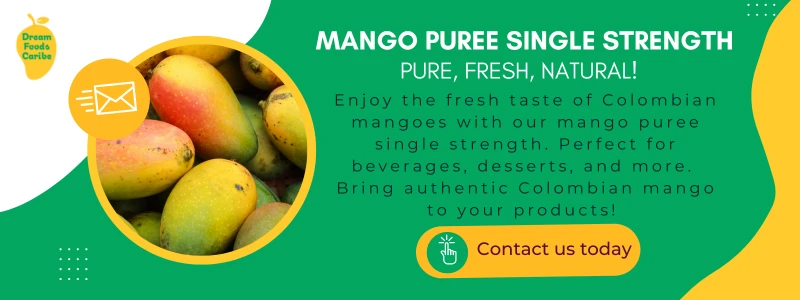In recent years, the United States has remained the world’s number one importer of various exotic fruits (OEC, 2023). In fact, when you visit a market, you are likely to find a long list of them. But do you know which ones are the favorites? We tell you about the ten bests for creating captivating food products.
What are exotic fruits?
Exotic fruits are usually characterized by their unique and intense flavor, vibrant colors, and distinctive appearance (Bond, 2024). They are referred to as fruits perceived as out of the ordinary. Tropical fruits may fall into this category.
In this regard, Colombia is a major exporter of this type of fruit. The most commonly sold varieties internationally are (Montenegro, 2022):
- Gulupa.
- Cape Gooseberry.
- Granadilla.
- Pitaya.
- Passion fruit.
- Tree tomato.
- Custard apple.
- Lulo.
- Curuba.
Also, the most popular markets for Colombian exotic fruits in recent years have been the Netherlands, the United States, Canada, and Germany. In these places, people eat them as fresh products and use them as ingredients for industrial food processing (Montenegro, 2022).
The appeal of exotic fruits
Their flavor and aroma profiles attract consumers. Some food industry analysts point out that fruits such as guava, pitaya, lychee and yuzu star in recent consumption trends (FONA International, 2021). For example, they are popular flavors of non-alcoholic beverages. People there appreciate the following (T. Hasegawa, 2022):
- Firstly: new flavors.
- Secondly: different flavors available for a limited time.
- Thirdly: products with international flavors.
Some leading exotic options in this category include passion fruit, pitaya, papaya, and açaí. This style of fruit is also popular in alcoholic beverages and sports drinks (T. Hasegawa, 2022).
On the other hand, international and indulgent flavors are important trends in dairy. Products such as yogurt often incorporate these types of fruits in combination with other fruits (T. Hasegawa, 2022).
In addition, many of these fruits offer important health benefits due to their nutritional content. This market is positioned to grow in the coming years, especially in response to the demand for healthy, organic or plant-based dietary products (OG Analysis, 2024).
Now, let’s explore the top ten of the best exotic fruits grown in Colombia.
Fascinating sweetness in exotic fruits
Many of Colombia’s exotic fruits offer captivating, sweet flavors. Keep reading to know more about them.
1. Sapote
This fruit grows widely in Central America, although it is also successfully cultivated in Colombia. Its pulp is soft and fibrous, with a particularly sweet flavor. For this reason, it is popular in desserts (Secretariat of Agriculture and Rural Development, 2021; Domínguez, 2023).
2. Pitaya
It comes from Central and South America. Its skin seems to have scales, so it is also known as dragon fruit. Additionally, it can be yellow or fuchsia, with a white, crunchy, and refreshing pulp, with a flavor like pear. It is a star ingredient in beverages, desserts, and confectionery (Davis, 2023; T. Hasegawa, 2022).
3. Custard apple
Native to the Andean region of South America. It has a green outer skin and a creamy, sweet white pulp, which is often likened to a combination of pineapple, strawberry, and banana. This makes it a popular choice for smoothies, juices, ice cream, and desserts (Davis, 2023).
4. Granadilla
This fruit has a hard orange peel, and a sweet interior of small seeds covered with a gelatinous pulp. It is a perfect input for the preparation of sauces (Bond, 2024; Montenegro, 2022).
5. Pineapple
It is characterized by its sweet and refreshing flavor. Its pulp is very juicy and aromatic, with a high water and fiber content. Consequently, these features make it appear in products such as juices, compotes, desserts, confectionery and sauces (Colombia CO, n.d.; T. Hasegawa, 2022).
The charm of sweet and sour in exotic fruits
These are the exotic fruits grown in Colombia that offer a perfect balance of sweet and sour flavors.
6. Passion fruit
Hailing from South America, the Colombian variety of passion fruit is particularly tart. This makes it a bold ingredient for preparing drinks, desserts, confectionery, and sauces (Bond, 2024; T. Hasegawa, 2022).
7. Gulupa
Native to the Amazon region, it is like passion fruit, only sweeter and more aromatic. Some preparations in which it stands out are ice creams, juices, jams, and desserts (Morales, 2021).
8. Cape gooseberry
It is native to Peru, but Colombia leads its exports (Fine Dining Lovers, 2022). This small orange fruit has a juicy, acidic, and sweet interior at the same time. It is used in confectionery and baked goods (Jeff, 2023).
9. Carambolo
The juicy, crisp flesh of the star fruit has a delicate bittersweet flavor, like a mixture of apple and pear, with a hint of sour. It comes from Southeast Asia and is used in desserts (Jeff, 2023; Bond, 2024).
10. Soursop
Native to Central and South America, it is a large fruit with a green, beaked skin. Its white interior is fibrous and creamy, with a sweet and slightly acid taste. As a result, its texture makes it ideal for making smoothies, drinks, and desserts (Jeff, 2023)
Food production with exotic fruits
There are several processing mechanisms to use them as an input in food production. One of the most widely applied is to convert them into purée so that they retain their nutrients and flavor, as well as natural sweeteners. In fact, purée is easier to transport and store than fresh fruit (Persistence Market Research, 2023). And, to top it off, tropical and exotic fruit purée dominates the global fruit purée market as of 2020 (KBV Research, 2021).
Additionally, other processing methods for these fruits include (Castellanos, 2023; Neologic, n.d.):
- Firstly, freezing to slow enzymatic and microbial activity.
- Secondly, dehydration to remove moisture.
- Thirdly, atomization to convert liquefied fruit to powder by rapid drying with hot gas.
- Fourthly, hot sealing in cans or jars.
- Fifthly, high-pressure processing deactivates bacteria and preserves nutritional quality.
As mentioned, producers position exotic fruits to capture the attention of consumers. They not only offer different flavors but also distinctive experiences. So, turning food consumption into an opportunity for indulgence and enjoyment is a leading industry trend that producers can maximize with these inputs.
Referencias Bibliográficas
- Bond, S. (2024, June 14). 40 exotic fruits from a to z (with photos!). Live Eat Learn.
- Castellanos, P. (2023, February 16). ¿Cuáles son los beneficios de la uchuva? IAlimentos.
- Colombia CO. (n.d.). Discover the tropical fruits of Colombia and the wonderful places where they come from.
- Davis, S. (2023, October 13). 11 exotic fruits you should try. WebMD.
- Domínguez, L. (2023, April 26). Zapote: ¿dónde se cultiva esta fruta en Colombia? El Tiempo.
- Fine Dining Lovers. (2022, May 7). Uchuva: qué es, propriedades y su uso en cocina.







